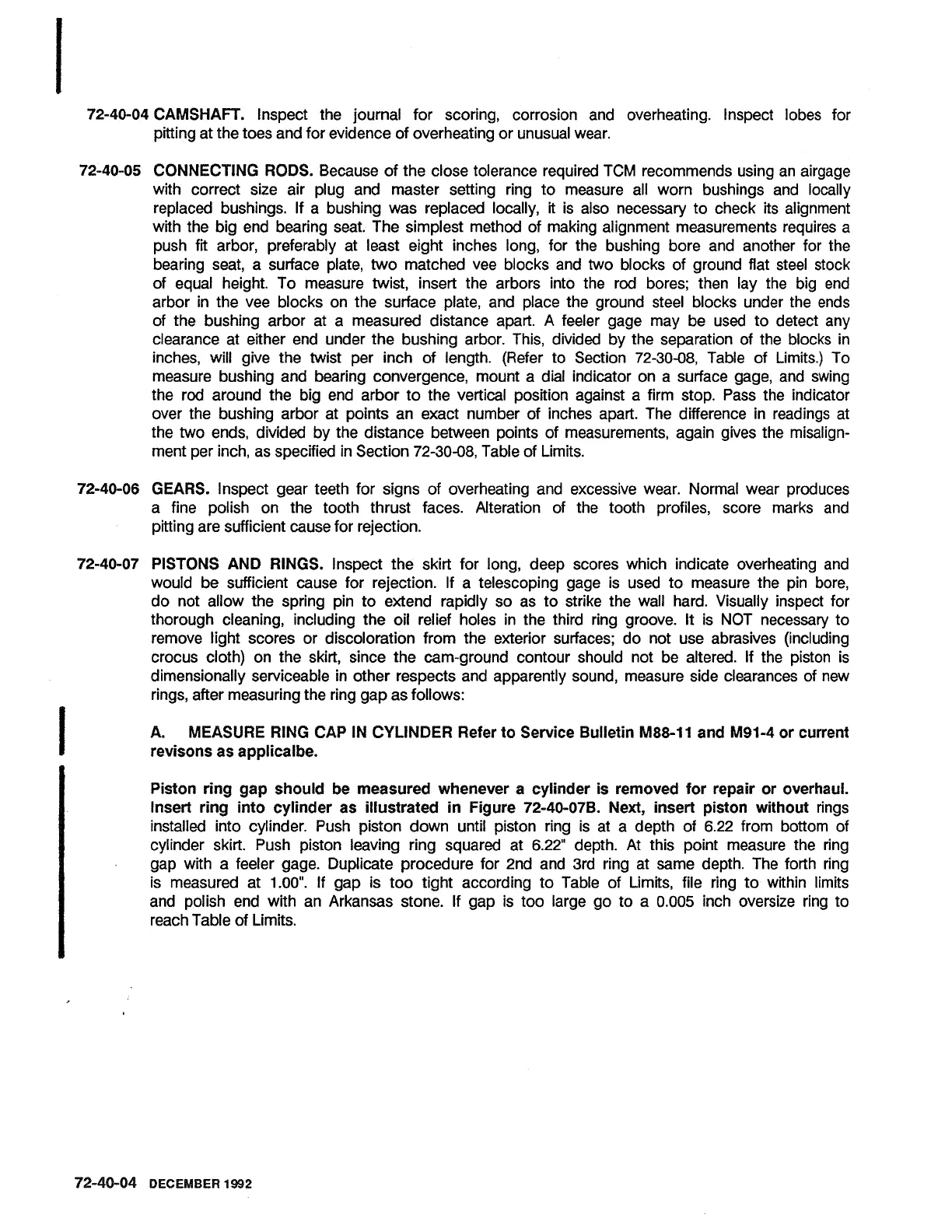72-40-04 CAMSHAFT.
lnspect the journal for scoring, corrosion and overheating. lnspect lobes for
pitting at the toes and for evidence of overheating or unusual wear.
72-40-05 CONNECTING RODS.
Because of the close tolerance required TCM recommends using an airgage
with correct size air plug and master setting ring to measure all worn bushings and locally
replaced bushings. If a bushing was replaced locally, it is also necessary to check its alignment
with the big end bearing seat. The simplest method of making alignment measurements requires a
push
fii
arbor, preferably at least eight inches long, for the bushing bore and another for the
bearing seat, a surface plate, two matched vee blocks and two blocks of ground flat steel stock
of equal height. To measure twist, insert the arbors into the rod bores; then lay the big end
arbor in the vee blocks on the surface plate, and place the ground steel blocks under the ends
of the bushing arbor at a measured distance apart. A feeler gage may be used to detect any
clearance at either end under the bushing arbor. This, divided by the separation of the blocks in
inches, will give the twist per inch of length. (Refer to Section
72-30-08, Table of Limits.) To
measure bushing and bearing convergence, mount a dial indicator on a surface gage, and swing
the rod around the big end arbor to the vertical position against a firm stop. Pass the indicator
over the bushing arbor at points an exact number of inches apart. The difference in readings at
the two ends, divided by the distance between points of measurements, again gives the misalign-
ment per inch, as specified in Section
72-30-08, Table of Limits.
72-40-06 GEARS.
lnspect gear teeth for signs of overheating and excessive wear. Normal wear produces
a fine polish on the tooth thrust faces. Alteration of the tooth profiles, score marks and
pitting are sufficient cause for rejection.
72-40-07 PISTONS AND RINGS.
lnspect the skirt for long, deep scores which indicate overheating and
would be sufficient cause for rejection. If a telescoping gage is used to measure the pin bore,
do not allow the spring pin to extend rapidly so as to strike the wall hard. Visually inspect for
thorough cleaning, including the oil relief holes in the third ring groove.
It
is NOT necessary to
remove light scores or discoloration from the exterior surfaces; do not use abrasives (including
crocus cloth) on the skirt, since the cam-ground contour should not be altered. If the piston is
dimensionally serviceable in other respects and apparently sound, measure side clearances of new
rings, after measuring the ring gap as follows:
A.
MEASURE RING CAP IN CYLINDER Refer to Service Bulletin
M88-11 and M91-4 or current
revisons as
applicalbe.
Piston ring gap should be measured whenever a cylinder is removed for repair or overhaul.
Insert ring into cylinder as illustrated in Figure
72-40-078. Next, insert piston without
rings
installed into cylinder. Push piston down until piston ring is at a depth of 6.22 from bottom of
cylinder skirt. Push piston leaving ring squared at 6.22" depth. At this point measure the ring
gap with a feeler gage. Duplicate procedure for 2nd and 3rd ring at same depth. The forth ring
is measured at 1.00".
If
gap is too tight according to Table of Limits, file ring to within limits
and polish end with an Arkansas stone. If gap is too large go to a 0.005 inch oversize ring to
reach Table of Limits.
72-40-04
DECEMBER
1992

